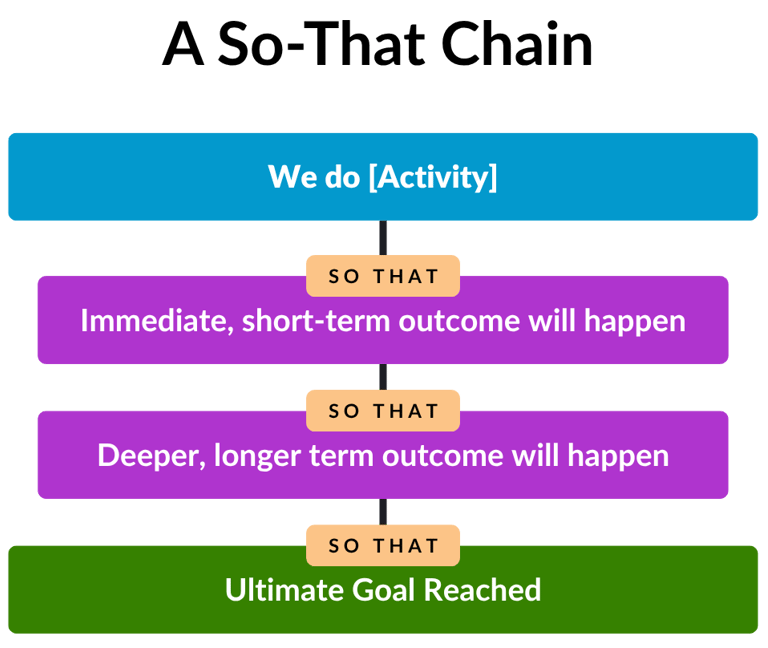8. Creating a Theory of Change Step 4: Linking Strategies to Outcomes and Goals
Brandon Booth
7/21/20258 min read
Never miss a post! Signup for my email updates today and get expert guidance delivered directly to your inbox!
Last week we tackled Steps 2 and 3: determining your specific strategies and the activities that will implement them. Now you have strategies and activities, but you might be wondering: "How do I know if these will actually work? How do I connect what I'm doing to the change I want to create?"
Today we'll tackle Step 4: identifying outcomes that link your strategies to your goals using "so-that" thinking. This is what the Annie E. Casey Foundation calls navigating the "messy middle"—the crucial bridge between your activities and your ultimate goal.
This step separates effective ministries from busy ones—it's where you create a clear pathway from what you do to the transformation you seek. Let's start by understanding what outcomes actually are.
Understanding Outcomes
What Are Outcomes?
Outcomes are the specific transformations you expect to see as people move from where they are now to where you want them to be. They're the changes that happen in people's lives as a result of your ministry's work.
Key insight: Outcomes are not activities—they're the results of activities. This distinction is crucial because many ministries confuse being busy with being effective.
Example: "Participants attend weekly support groups" is an activity. "Participants feel safe sharing their struggles" is an outcome. The activity is what you do; the outcome is what changes in people as a result.
The Difference Between Outputs and Outcomes:
Outputs: What you produce (number of people served, programs run, meals provided). These are important for tracking your work, but they don't tell you if you're creating change.
Outcomes: How people change as a result (increased hope, stronger relationships, deeper faith). These are what actually matter for your mission.
Why this matters: Many ministries measure outputs but never identify the outcomes that actually matter. They can tell you how many people came to their program, but they can't tell you if those people's lives were transformed. Without clear outcomes, you're flying blind.
Types of Outcomes:
Short-term outcomes: Changes you expect to see relatively quickly (weeks to months). These are often the first signs that your ministry is having an impact.
Medium-term outcomes: Changes that take longer to develop (months to a year). These represent deeper shifts in people's lives.
Long-term outcomes: The deeper transformations that align with your ultimate goal (1-3 years). These are the lasting changes that fulfill your ministry's purpose.
Example progression: Feel safe → Experience God's love → Develop coping skills → Experience lasting freedom
Notice how each outcome builds on the previous one, creating a logical pathway from initial engagement to ultimate transformation.
How Outcomes Differ in Christian Ministry:
Your outcomes will include heart transformation, not just behavior change. You're not just trying to modify what people do—you're seeking to transform what they want and love.
Your outcomes recognize the Holy Spirit's role in creating change. You're partnering with God in transformation, not trying to manufacture it through human effort alone.
Your outcomes account for the non-linear nature of spiritual growth. People don't change in straight lines—they have setbacks, breakthroughs, and seasons of slow growth.
The Power of "So-That" Thinking
What Is "So-That" Thinking?
"So-that" thinking is a logical chain that connects each activity to the next level of change. It's a simple but powerful tool for mapping the pathway from what you do to the transformation you seek.
The format: "We do [activity] so that [immediate outcome] so that [deeper outcome] so that [ultimate goal]"
Why it works: It forces you to think through the actual pathway of change, not just hope change will happen. Many ministries assume their activities will automatically lead to transformation, but "so-that" thinking makes you articulate exactly how that will happen.


How "So-That" Chains Work:
Start with an activity and ask "so that what?" Don't just assume the activity is good—identify what specific change it's supposed to create.
Keep asking "so that what?" until you reach your ultimate goal. Each "so that" should represent a logical step in the transformation process.
Each link should be logical and based on your understanding of how change happens. Don't just hope one thing leads to another—have good reasons to believe it will.
Example: "We provide mentoring so that youth feel valued so that they experience God's love so that they develop secure identity in Christ"
Building Effective "So-That" Chains:
Make each link specific and measurable: "Feel better" is too vague. "Experience reduced anxiety about their future" is specific enough that you could recognize it if you saw it.
Base links on evidence or experience: Don't just hope one thing leads to another—have good reasons to believe it will. This might come from research, your own experience, or the experience of similar ministries.
Include heart-level changes: Remember, you're after heart transformation, not just behavior modification. Your "so-that" chains should show how hearts will be engaged and changed.
Account for obstacles: If shame is a barrier (from your Step 1 analysis), your chain should show how you'll address it. Don't ignore the obstacles you identified earlier.
Examples of Ministry "So-That" Chains:
Recovery Ministry: "We provide peer mentoring so that participants feel safe sharing their struggles so that they experience acceptance and grace so that their hearts become open to God's love so that they find strength to address their addiction so that they experience lasting freedom."
Youth Ministry: "We create small group discipleship so that teenagers develop authentic relationships with adults so that they feel safe being vulnerable so that they can process their identity questions so that they experience God's delight in them so that they develop secure identity in Christ."
Marriage Ministry: "We facilitate couple retreats so that spouses have uninterrupted time together so that they can share their hearts without daily distractions so that they experience God's heart for their marriage so that they develop renewed intimacy."
Notice how each chain includes both practical and heart-level changes, and how each step logically leads to the next.
Testing Your "So-That" Chains:
The Logic Test: Does each step logically lead to the next? If someone experienced the first outcome, would it naturally lead to the second?
The Evidence Test: Do you have good reason to believe this progression will happen? Is it based on research, experience, or sound reasoning?
The Heart Test: Does the chain include heart transformation, not just behavior change? Are you addressing desires and motivations, not just actions?
The Obstacle Test: Does the chain address the barriers you identified in Step 1? If shame is an obstacle, does your chain show how you'll create safety?
Identifying Your Outcomes
Start with Your Goal and Work Backward:
Begin with your ultimate goal from Step 1. This is your destination—the transformation you want to see.
Ask: "What would need to be true right before someone experiences this transformation?" Work backward from your goal to identify the immediate precursor.
Then ask: "What would need to be true before that?" Keep working backward, identifying each step in the transformation process.
Continue until you reach the immediate outcomes of your activities. You should be able to trace a clear path from your activities all the way to your ultimate goal.
Consider Different Types of Changes:
Knowledge changes: What do people need to understand differently? This might include understanding God's character, their own identity, or practical skills.
Attitude changes: How do their feelings and perspectives need to shift? This includes changes in hope, confidence, trust, and emotional well-being.
Skill changes: What new abilities do they need to develop? This might include communication skills, coping strategies, or spiritual disciplines.
Behavior changes: What actions need to change? While behavior isn't your ultimate goal, it's often part of the transformation process.
Relationship changes: How do their connections with God and others need to grow? Relationships are often both a means and an end in Christian ministry.
Heart changes: What desires and motivations need to be transformed? This is the deepest level of change and often the most important for lasting transformation.
Use Your Understanding of Heart Change:
Remember the 6 theological assumptions from Article 3. How do these principles apply to your specific context and the changes you're seeking?
Account for resistance: How will hearts move from resistance to openness? What will create the safety and trust necessary for people to be vulnerable?
Include encounters with God: Where in your pathway do people experience his love? These encounters are often the catalyst for deeper transformation.
Consider the role of community: How do relationships facilitate transformation? Community is often essential for both creating safety and sustaining change.
Remember to Check Your Assumptions:
At each step, ask: "What am I assuming about how this change happens?" Make your assumptions explicit rather than leaving them hidden.
Question your assumptions: Are they based on evidence or just hope? It's okay to have assumptions, but you should be aware of them and test them.
Be willing to adjust: If your assumptions prove wrong, modify your pathway. Your Theory of Change should be a living document that evolves as you learn.
Document your assumptions: Write them down so you can test them later. This will help you learn and improve your approach over time.
Your Next Step
Exercise 1: The "So-That" Chain Builder
Choose one of your key strategies from Article 7
Start with a specific activity and build a "so-that" chain to your ultimate goal (E.g. "We do [activity] so that [immediate outcome] so that [deeper outcome] so that [deeper outcome] so that [ultimate goal].")
Make each link specific and logical
Test the chain with the four tests mentioned above
Exercise 2: The Assumption Audit
For each link in your "so-that" chains, write down what you're assuming
Ask: "What evidence do I have that this assumption is true?"
Identify which assumptions you most need to test
Take time to work through these exercises carefully. The clarity you gain about your outcomes will help you design better programs and measure what really matters.
What's Next
You've got your activities, outcomes, and strategies, but how do you know if they're working? The answer lies in measuring what really matters.
Next week, I'll show you Step 5: how to measure success in ways that actually reflect the heart transformation you're seeking—because what you measure is what you value. We'll explore why traditional metrics often miss the point in ministry and how to develop measures that capture the changes that matter most.
Need help connecting your strategies to meaningful outcomes? I'd love to help you think through the pathway from your activities to your goal. Creating clear "so-that" chains requires thinking through the actual mechanics of transformation, and sometimes it helps to have someone ask the right questions and help you see connections you might miss. Schedule a free 30-minute conversation with me, and let's work together to map the pathway from your ministry activities to the heart transformation you're seeking.
-------------------
This is the eighth article in our series "A Theory of Change: Building a Ministry that Actually Changes Lives!" ← See the previous article, or check out the next article here →


Let's build!
Connect with me today and let's start building your ministry that will change lives!
© Brandon Booth, 2025
Expert guidance for nonprofits and ministries.
Brandon Booth



